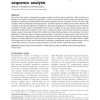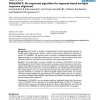204 search results - page 9 / 41 » Multiple Sequence Alignment Based on Profile Alignment of In... |
101
click to vote
BMCBI
2010
14 years 11 months ago
2010
Background: Determining beforehand specific positions to align (anchor points) has proved valuable for the accuracy of automated multiple sequence alignment (MSA) software. This f...
BIB
2006
14 years 11 months ago
2006
One of the major goals of computational sequence analysis is to find sequence similarities, which could serve as evidence of structural and functional conservation, as well as of ...
118
click to vote
BMCBI
2004
14 years 11 months ago
2004
Background: Parallel computing is frequently used to speed up computationally expensive tasks in Bioinformatics. Results: Herein, a parallel version of the multi-alignment program...
NAACL
2010
14 years 9 months ago
2010
Producing a fluent ordering for a set of prenominal modifiers in a noun phrase (NP) is a problematic task for natural language generation and machine translation systems. We prese...
BMCBI
2005
14 years 11 months ago
2005
Background: We present a complete re-implementation of the segment-based approach to multiple protein alignment that contains a number of improvements compared to the previous ver...



